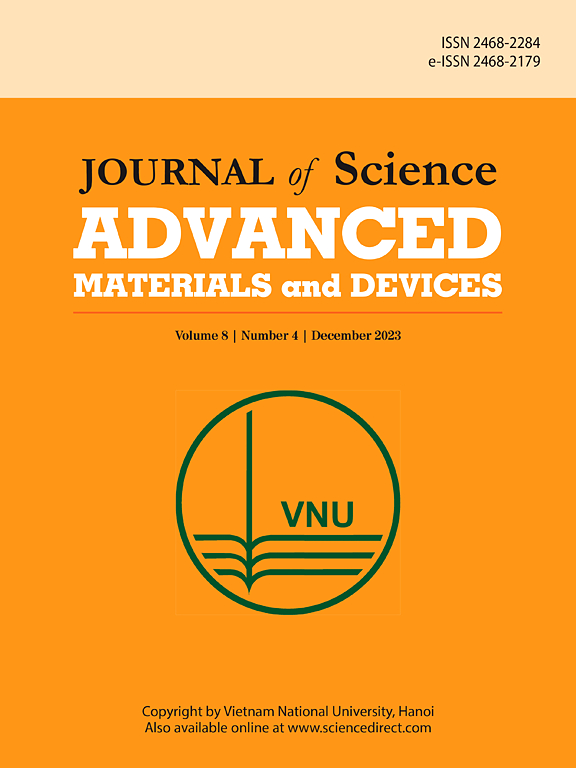用跨尺度微磁模拟方法评价多源磁性器件中永磁体的实际磁性能
IF 6.8
3区 材料科学
Q1 MATERIALS SCIENCE, MULTIDISCIPLINARY
Journal of Science: Advanced Materials and Devices
Pub Date : 2025-07-07
DOI:10.1016/j.jsamd.2025.100940
引用次数: 0
摘要
在多源磁性器件(msmd)中,永磁体(pm)的磁化状态受到周围pm产生的叠加磁场的影响,这给其实际磁性能的准确评估和选择带来了很大的挑战。这种干扰在复杂的磁性系统中尤其明显,如哈尔巴赫阵列,其中传统的非线性磁化模型经常产生扭曲或不可靠的结果。为了解决这个问题,我们提出了一种基于磁矩动力学的跨尺度数值方法来评估msmd内pm的实际磁性能。该方法为将微磁模拟应用于宏观器件级永磁体的磁性性能评估建立了参考框架。通过耦合具有热磁相互作用的Maxwell方程和Landau-Lifshitz-Gilbert (LLG)方程,建立了一个本禀磁化模型。使用基于三维voronoi的多晶参数化校准矫顽力和主导磁化反转机制(成核和钉住)。通过空间分布的阻尼修正系数对主磁相的有效尺寸进行缩放,构建了跨尺度的仿真框架。在微磁模拟与实验消磁曲线吻合较好的情况下,对不同烧结钕铁硼磁体在现有halbach型永磁励磁同轴驱动器(pmecd)和永磁同步电机(PMSMs)中不同位置的等效剩磁率和消磁率进行了计算。主要发现包括局部磁化反转引起的场衰减和哈尔巴赫阵列自退磁引起的多畴形成。该方法为MSMD应用中永磁材料的磁性性能评估和预设计优化提供了可靠的参考。本文章由计算机程序翻译,如有差异,请以英文原文为准。
Evaluating the practical magnetic properties of permanent magnets in multi-source magnetic devices via cross-scale micromagnetic simulation method
In multi-source magnetic devices (MSMDs), the magnetization states of permanent magnets (PMs) are affected by the superimposed magnetic fields generated by surrounding PMs, making the accurate evaluation and selection of their practical magnetic properties highly challenging. This interference is particularly pronounced in complex magnetic systems such as Halbach arrays, where conventional nonlinear magnetization models often produce distorted or unreliable results. To address this issue, we propose a cross-scale numerical method based on magnetic moment dynamics to assess the practical magnetic performance of PMs within MSMDs. This method establishes a reference framework for applying micromagnetic simulations to the magnetic performance evaluation of macroscale, device-level permanent magnets. An intrinsic magnetization model is developed by coupling the Maxwell and Landau–Lifshitz–Gilbert (LLG) equations with thermomagnetic interactions. The coercivity and dominant magnetization reversal mechanisms (nucleation and pinning) are calibrated using a 3D Voronoi-based polycrystalline parameterization. A cross-scale simulation framework is constructed by scaling the effective dimensions of the main magnetic phase through spatially distributed damping correction coefficients. With strong agreement between micromagnetic simulations and experimental demagnetization curves, the equivalent remanence and demagnetization rates of various sintered NdFeB magnets are evaluated at different positions within existing Halbach-type permanent magnet excited coaxial drives (PMECDs) and permanent magnet synchronous machines (PMSMs). Key findings include field attenuation caused by local magnetization reversal and multi-domain formation due to self-demagnetization in Halbach arrays. The proposed method offers a reliable reference for magnetic performance assessment and pre-design optimization of PMs in MSMD applications.
求助全文
通过发布文献求助,成功后即可免费获取论文全文。
去求助
来源期刊

Journal of Science: Advanced Materials and Devices
Materials Science-Electronic, Optical and Magnetic Materials
CiteScore
11.90
自引率
2.50%
发文量
88
审稿时长
47 days
期刊介绍:
In 1985, the Journal of Science was founded as a platform for publishing national and international research papers across various disciplines, including natural sciences, technology, social sciences, and humanities. Over the years, the journal has experienced remarkable growth in terms of quality, size, and scope. Today, it encompasses a diverse range of publications dedicated to academic research.
Considering the rapid expansion of materials science, we are pleased to introduce the Journal of Science: Advanced Materials and Devices. This new addition to our journal series offers researchers an exciting opportunity to publish their work on all aspects of materials science and technology within the esteemed Journal of Science.
With this development, we aim to revolutionize the way research in materials science is expressed and organized, further strengthening our commitment to promoting outstanding research across various scientific and technological fields.
 求助内容:
求助内容: 应助结果提醒方式:
应助结果提醒方式:


